On Sunday, Dec. 15, 2019, at approximately 8:50 a.m., I stepped off the starting line of the BMW Dallas Marathon and began my first official 26.2-mile race. One of my 2019 goals was coming to fruition, and as the race began, I felt cool, calm, and confident; I had no illusions about how difficult this was going to be.
I’m not one of those people who makes New Year’s Resolutions, but I do consider myself someone who performs best when they have clearly defined and measurable goals to work toward. So before 2019 started, I somewhat impulsively decided to run the BMW Dallas Marathon.
In the interest of full transparency, I need to state for the record that running brings me absolutely zero pleasure.
Prior to enlisting in the military, I did find some enjoyment in a nice, brisk run; however, the U.S. Army found a way to kill that tiny joy, as it’s known to do for so many things. Since then, running has held the position of a necessary evil in my life. So when I set out to accomplish this task, it was merely to identify a challenge in order to overcome it.
When I initially signed up, I had no other goal in mind besides completing the race. To be completely honest, I didn’t really care if I even managed to pull off the gold standard “four hours or less marathon.” I just didn’t want to finish with an embarrassing time stamp next to my name in the official results.
The Race
For the first several miles of the race, I found myself having to make a deliberate effort to hold back on my pace; the frequent opportunity to pass slower runners with quick bursts of speed presented a tantalizing chance to inflate my ego, a risk I knew and did my best to avoid.In fact, the first five miles seemed to fly past easier than any other five miles I had run in my life. I was aware that this type of thinking was a recipe for failure fed by over-confidence. I eased off on my speed if I saw myself closing in on the 4:15 pace team and made sure that the 4:30 pace team remained comfortably distant behind me. I toyed with the idea of trying to catch the four-hour team in the final stretch, but let that idle thought slip below the surface of my mind in order to be present in the current moment.
I found myself slowing down at the halfway point and realized that I was going to have to step it out a bit to make up for my sluggish performance on some of the inclines; when I found the equivalent declines, I began to make a concerted effort to capitalize on gravity and my natural momentum.
Throughout the race, at somewhat frequent intervals, there were hydration stations and the occasional source of quick energy. Many of the more serious runners had brought their own sources of fast fuel, often in the form of gel packs. At these stations, people would down their water and Gatorade, then throw the cups on the ground. This often resulted in a strange, sludgy mess made from various fluids and energy goops.
It was at one of these points that I hit a slick spot with my heel at just the right angle, at just the right incline, and I skidded.
It wasn’t dramatic and I didn’t come anywhere close to falling, but the way my foot twisted in one direction as my leg and body moved in opposite directions resulted in a pop and a blinding flash of white light.
Almost instantaneously, I was incapable of running at even the slowest of jogs. The pain was somewhat intense, but I could work with that. However, I found myself in a strange place for the first time in my life, where my body betrayed me and wouldn’t do what I wanted it to do.
I was doing the one thing I had sworn I would never do during this or any competition: I was walking. Worse than that, I was barely moving forward. I found myself thinking that the absolute best I could hope for was to finish; that was the honorable compromise I was making with myself. No matter what, I was crossing that finish line. My ego wouldn’t allow anything less.
I had blown through my primary course of action, flown right past anything resembling an alternate plan, and found myself worrying if there was even a contingency option. As I limped past the 15-mile marker, I struggled knowing that, at my current pace, I would likely hit the time limit and be forced to quit. Still, I was too proud to let this deter me. Through sheer force of will, I arrogantly thought that I could still manage to complete the race, despite barely being able to walk.
Before I knew it, race staff were approaching me and calling for a medic. I tried to shrug them off, but it wasn’t going to work. My race was over. I found myself failing at something that I hadn’t even considered I wouldn’t succeed at. It was a crushing, alien feeling to me. Wasn’t I the guy who set his mind on something and made it happen, no matter the cost? Yet, I found myself arriving back at the starting point in a van with people afflicted by various injuries and ailments, some more severe and many less so.
2019 was going to end with a check mark in the L column.
I let myself have until the next morning to grieve and to feel bad for myself. I processed my emotions and then went to bed. Tomorrows are for planning, not obsessing over the past. I spent the next day evaluating what had happened, where I had failed, and what could have been different. In the military, we called them After Action Reviews (AARs), and we used them to assess our performance and improve ourselves for the next round.
On Tuesday, Dec. 17, 2019, at approximately 6:30 a.m., I took the first slow, painful steps that would became my first training mile since a painful and devastating failure two days prior. I was sore and I barely limped along the route in my neighborhood, but I felt cool, calm, and confident; I had no illusions about how difficult this was going to be.





